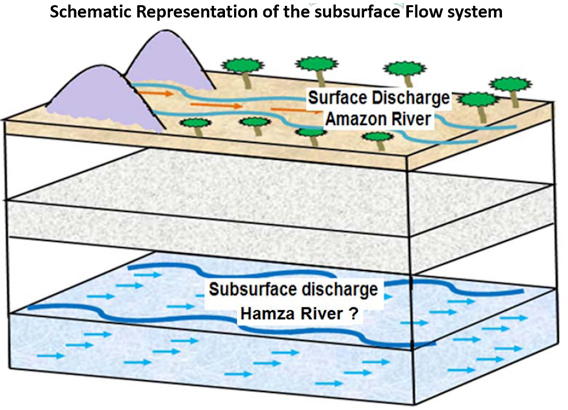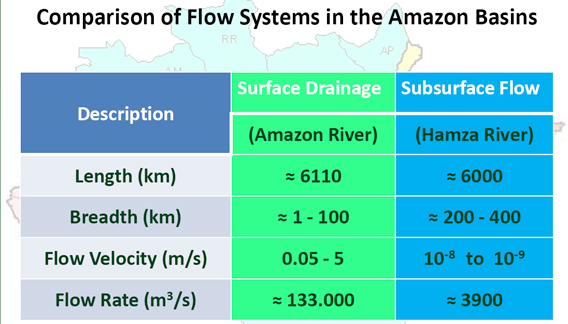
Researchers at Brazil’s National Observatory have discovered evidence of a massive underground river flowing deep beneath the Amazon River, reports the AFP.
Presenting this week at the 12th International Congress of the Brazilian Geophysical Society in Rio de Janeiro, Elizabeth Tavares Pimentel reported the existence of a 6,000-kilometer-long (3,700-mile) river flowing some 4,000 meters (13,000 feet) under the Amazon.
Like the Amazon, the river flows west to east, but is considerably wider (200-400 kilometers) and moves at only a fraction of the speed of the giant surface river. The hidden river — dubbed the Hamza after Pimentel’s supervisor Valiya Hamza — discharges into the Atlantic deep underground.
“It is likely that this river is responsible for the low level of salinity in the waters around the mouth of the Amazon,” said a statement released by the National Observatory.
“The Amazon region has two discharge fluid systems: the surface drainage [through] the Amazon River… and the flow of groundwater through the deep sedimentary layers.”

Pimentel’s research is based on analysis of 241 oil wells drilled by state oil company Petrobras in the 1970s and 1980s. The study area covers the sedimentary basins of Acre, Solimões, Amazonas, Marajó and Barreirinhas.
The Amazon is Earth’s largest river — every day up to 17 billion metric tons of water flow into the Atlantic Ocean. For reference, the Amazon discharges enough fresh water daily into the Atlantic to supply New York City’s freshwater needs for nine years. The force of the current causes Amazon River water to continue flowing 125 miles out to sea before mixing with Atlantic salt water. Early sailors could drink fresh water out of the ocean before sighting the South American continent.
Update (Aug 27) Richard Black of BBC News is reporting that the “river” is “not a river in the conventional sense.”
Another Brazilian expert said the groundwater was known to be very salty. Professor Hamza, who conducted the original analysis with Elizabeth Tavares Pimentel, said they “used the term ‘river’ in a more generic sense than the popular notion.” |
Related articles
Last chance to see: the Amazon’s Xingu River

(06/15/2011) Not far from where the great Amazon River drains into the Atlantic, it splits off into a wide tributary, at first a fat vertical lake that, when viewed from satellite, eventually slims down to a wild scrawl through the dark green of the Amazon. In all, this tributary races almost completely southward through the Brazilian Amazon for 1,230 miles (1,979 kilometers)—nearly as long as the Colorado River—until it peters out in the savannah of Mato Grosso. Called home by diverse indigenous tribes and unique species, this is the Xingu River.

(06/03/2011) As an American I know a lot about shame — the U.S. government and American companies have wrought appalling amounts of damage the world over. But as an admirer of Brazil’s recent progress toward an economy that recognizes the contributions of culture and the environment, this week’s decision to move forward on the Belo Monte dam came as a shock. Belo Monte undermines Brazil’s standing as a global leader on the environment. Recent gains in demarcating indigenous lands, reducing deforestation, developing Earth monitoring technologies, and enforcing environmental laws look more tenuous with a project that runs over indigenous rights and the environment.
Marathon swimmer: an interview with the first man to swim the length of the Amazon

(01/23/2011) Explorers have been making their way down the world’s mightiest river for hundreds of years. Untold numbers of people have not completed the journey, drowning in its murky waters, being eaten by animals, losing their way, succumbing to tropical disease, being killed by pirates or hostile local populations. But today a trip down the Amazon is less special—it has even been rafted and kayaked by a few intrepid souls. Traversing the majority of the Amazon can be done easily by commercial boat, provided you have the time and a lot of patience. But then in 2007 a Slovenian did something amazing: he swam the entire length of the river. The adventure took 66 days and exacted a heavy physical and mental toll, but Martin Strel survived and in so doing conveyed a simple, but powerful message to the world: we are part of the our environment.
NASA image reveals worst drought on record for the Amazon river
(12/15/2010) A new image released by NASA reveals the impact of the worst drought on record on the world’s largest river.
Google Earth animation shows Brazilian plans to turn Amazon into ‘series of stagnant reservoirs’

(08/30/2010) The decision last week by the Brazilian government to move forward on the $17 billion Belo Monte Dam on the Xingu river will set in motion a plan to build more than 100 dams across the Amazon basin, potentially turning tributaries of the world’s largest river into ‘an endless series of stagnant reservoirs’, says a new short film released by Amazon Watch and International Rivers.
NASA photos show severe flooding in the Amazon
(07/22/2009) Photos released by NASA highlight last month’s severe flooding of the Amazon River near the Brazilian city of Manaus.
New species of river dolphin discovered in the Amazon
(04/30/2008) Researchers have identified a new species of river dolphin in the Bolivian Amazon according to the Whale and Dolphin conservation Society (WDCS). The announcement was made at a conservation workshop in Santa Cruz de la Sierra in Bolivia.
Overfishing may hurt Amazon forest trees
(02/05/2008) Overfishing is reducing the effectiveness of seed dispersal by fish in the Brazilian Pantanal, reports Nature. The research suggests that fishing practices can affect forest health.